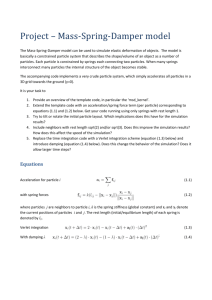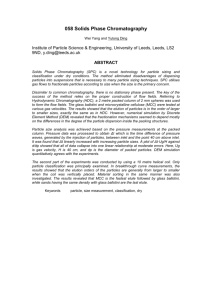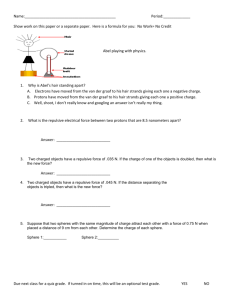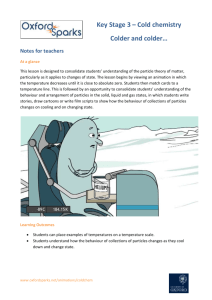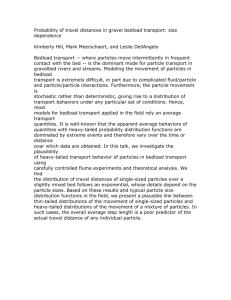Lecture 4
advertisement
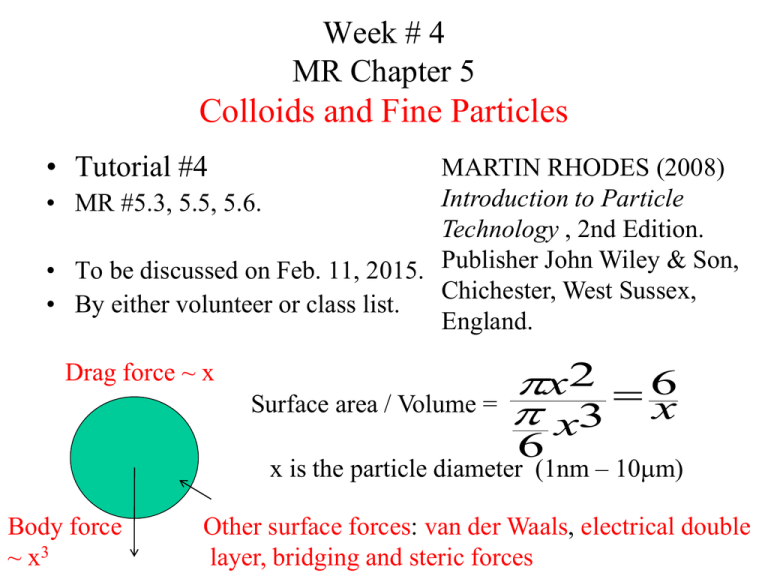
Week # 4 MR Chapter 5 Colloids and Fine Particles • Tutorial #4 MARTIN RHODES (2008) Introduction to Particle • MR #5.3, 5.5, 5.6. Technology , 2nd Edition. • To be discussed on Feb. 11, 2015. Publisher John Wiley & Son, Chichester, West Sussex, • By either volunteer or class list. England. Drag force ~ x Surface area / Volume = x2 6 x3 x 6 x is the particle diameter (1nm – 10mm) Body force ~ x3 Other surface forces: van der Waals, electrical double layer, bridging and steric forces Brownian motion Robert Brown (1827) Thermal energy from environment causes the molecules of the liquid to vibrate. These vibrating molecules collide with each other and with the surface of the particles. Illustration of the random walk of a Brownian particle. The distance the particle has moved over a period of time is L 3kT m 3 1 2 Random thermal energy kT mv Ignoring drag, collision and other factors 2 2 (Einstein, 1956) Based on statistical analysis of 1-D random walk to determine root mean square distance traveled. k: Boltzmann constant = 1.381 x 10-23 J/K f: friction coefficient = FD/U x is the particle diameter Extension to 3D case: L 6t Surface forces dV F dD • Van der Waals Forces A group of electrohydrodynamic interactions that occur between the atoms in two different particles. Notation used to indicate the type of material for each particle and the intervening medium Dielectric properties of medium 2 is between materials 1 & 3. • Electrical double layer forces Number density per unit area of neutral (M-OH), positive (M-OH2+) and negative (M-O-) surface sites as a function of pH A measure of the counterion cloud (thus the range of the repulsion) is the Debye length , k-1 3.29 [c] (nm-1 ) Approximate EDL potential energy VEDL 0 x e 2 D 0 Zeta potential of alumina particles as a function of pH and salt concentration • Adsorbing polymers, bridging and steric forces Schematic representation of (a) bridging flocculation and (b) steric repulsion • Net interaction force DLVO Theory: • Result of surface forces on behaviour in air and water • Influences of particle size and surface forces on solid/liquid separation by sedimentation 2kT L 3 xm t 2 x g P f 18m t t 216kT m g P f x5 2 2 • Suspension rheology Einstein (1906), < 7% volume solids) Batchelor (1977), 7-15%, volume solids Relative viscosity (ms / ml) of hard sphere silica particle suspensions (black circles) and Einstein’s relationship (line) The transition from Brownian dominated random structures to preferred flow structures as shear rate is increased is the mechanism for the shear thinning behaviour of concentrated suspensions of hard sphere colloids Influences of surface forces on suspension flow • Repulsive forces eff volume of solid + excluded volume total volume • Attractive forces Force versus separation distance curves for alumina particles Force versus separation distance curves for oil droplets


